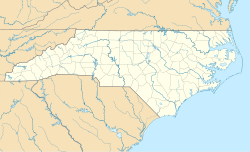Reynolds Building
|
Reynolds Building
|
|

Reynolds Building street view
|
|
| Location | 51 E. 4th St., Winston-Salem, North Carolina |
|---|---|
| Coordinates | 36°5′56″N 80°14′40″W / 36.09889°N 80.24444°WCoordinates: 36°5′56″N 80°14′40″W / 36.09889°N 80.24444°W |
| Area | 0.55 acres (0.22 ha) |
| Built | 1928-1929 |
| Built by | James Baird Company |
| Architect | Shreve and Lamb |
| Architectural style | Art Deco |
| NRHP Reference # | 14000494 |
| Added to NRHP | August 19, 2014 |
The Reynolds Building is a 314-foot (96 m) Art Deco skyscraper at 51 E. 4th Street in Winston-Salem, Forsyth County, North Carolina with 313,996 square feet (29,171.2 m2) of space. It was completed in 1929 and has 21 floors. In April 2016, its first six floors opened as the Kimpton Cardinal Hotel, with apartments located on the 11 floors above.
When completed as the headquarters of R. J. Reynolds Tobacco Company, it was the tallest building in the United States south of Baltimore, Maryland, and it won a national architecture award. The building is well known for being a design inspiration for the much larger Empire State Building that was built in 1931 in New York City. Every year the staff of the Empire State Building sends a Father's Day card to the staff at the Reynolds Building in Winston-Salem to pay homage to its role as predecessor to the Empire State Building. It was listed on the National Register of Historic Places in 2014.
The building was designed, just as the Empire State Building, for the purpose of corporate offices with retail outlets on the first floor.Shreve & Lamb, the architects, were asked for "an effect of conservatism along with attractiveness, but to avoid flashiness." But regarding the result, a 1997 Winston-Salem Journal article said, "city residents could be forgiven for wondering whether the architects followed the directive" because "Gray-brown marble from Missouri, black marble from Belgium and buff-colored marble from France covered the walls and floor. The ceiling was festooned with gold leaves, and the grillwork, elevator doors and door frames were bright, gleaming brass." The hurt the Reynolds Building's leasing business temporarily, but it was more successful than other similar buildings at leasing offices. Its promotional brochure said that the 14th, 15th, and fourth floors were reserved for doctors and dentists, but this might not have been the case. Most of the offices were occupied by organizations related to the tobacco industry, such as railroads, insurance companies, and attorneys.
...
Wikipedia


